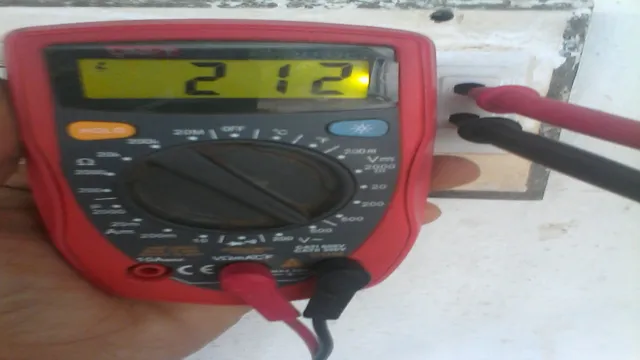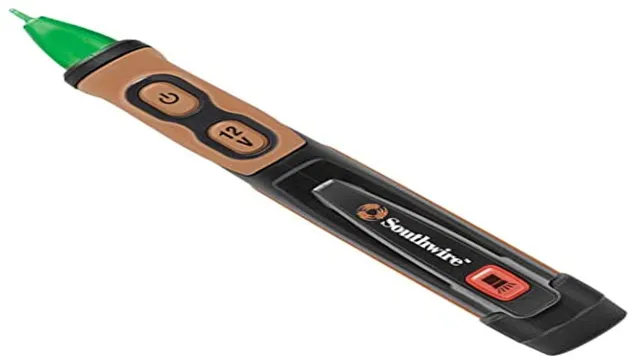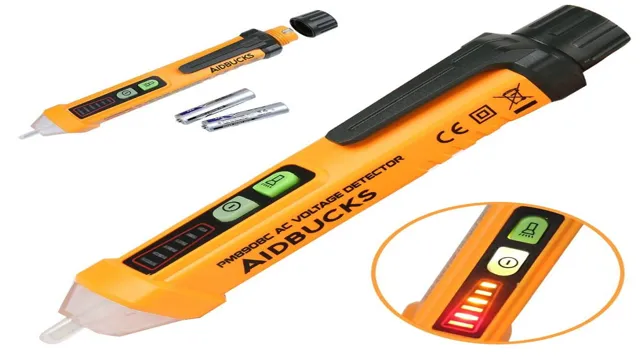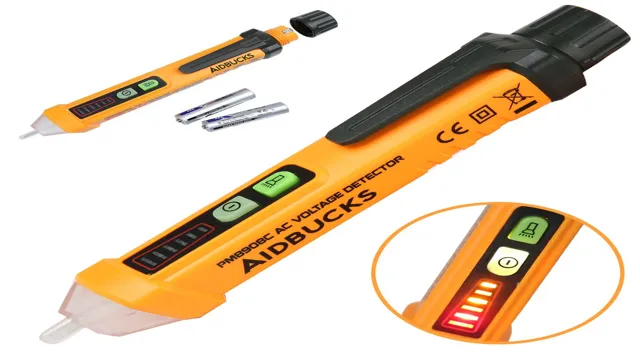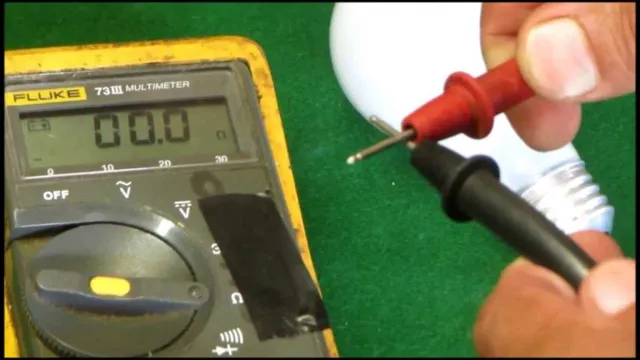How to Use a Voltage Tester on a Battery: Tips and Tricks for Accurate Readings
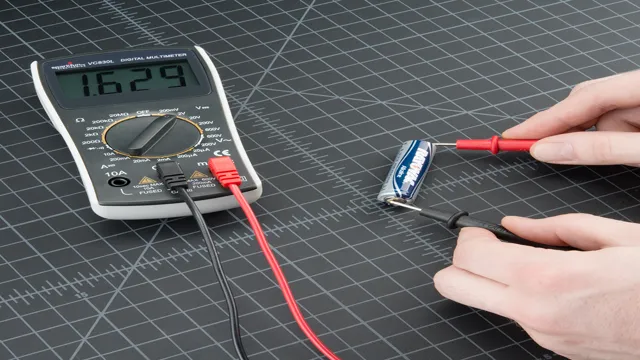
Have you ever wondered whether your battery is performing as it should be? Maybe you suspect that it’s not holding a charge well or you’re seeing some other issues, but how can you be sure? That’s where a voltage tester comes in handy. By using a voltage tester on your battery, you can quickly and easily determine its charge level and whether it’s experiencing any problems. It’s like giving your battery a check-up to ensure it’s in top shape.
Think of it like taking your car to the mechanic for a tune-up. Just as you trust them to find any issues with your car, a voltage tester can help you identify any issues with your battery. In this post, we’ll dive deeper into the topic of using a voltage tester on a battery and help you better understand what it can do for you.
So, let’s get started!
Understanding the voltage tester
If you are wondering how to use a voltage tester on a battery, then it is important to understand what a voltage tester is and how it works. A voltage tester is a handy tool that can help you determine if there is electrical current flowing through a circuit or battery. To use a voltage tester on a battery, first, you need to identify the positive and negative terminals of your battery.
Then, holding the voltage tester in one hand, touch the probe to the positive terminal of the battery and the other probe to the negative terminal. If the voltage tester lights up or makes a noise, then it means that there is electrical current flowing through the battery. On the other hand, if the voltage tester does not light up or make a noise, then it means that the battery is dead or not functioning properly.
Overall, using a voltage tester is a simple and effective way to test your batteries and ensure that they are working correctly.
Different types of voltage testers
Voltage testers come in different types, each with its unique features and applications. One of the most common and basic types is the neon light or contact tester, which uses a neon bulb to detect the presence of voltage. It’s simple to use, and its main advantage is that it can detect voltage in live wires.
Another type is the non-contact voltage tester, which allows you to test for voltage without touching the wire or electrical component. The non-contact voltage tester uses an electromagnetic field to detect the presence of voltage. This type is more popular because of its safety and ease of use.
A third type is the digital multimeter, which not only measures voltage but also current and resistance. The digital multimeter is more versatile compared to the other types, but it’s also more complex to use and requires more technical knowledge. Understand the different types of voltage testers and choose the one that best suits your needs to ensure your safety when working with electricity.

Reading the display
When it comes to understanding voltage testers, one of the key aspects is reading the display. The display is where you can see the results of the measurements made by the tester and make important decisions based on the information provided. While different voltage testers may have different types of displays, many have similar features such as digital screens that display the voltage reading in numerical form, as well as color-coded indicators that show whether the voltage is within a safe range or not.
It’s important to know how to interpret the display correctly to understand the voltage readings correctly. For example, a reading of 120 volts may indicate a safe level of voltage for some appliances, but too much voltage for others. Being able to read the display correctly can help prevent accidents, protect your equipment, and make sure your electrical systems are running safely and efficiently.
Preparing the battery for testing
Using a voltage tester on a battery is a simple process that requires a bit of preparation beforehand. The first step is to ensure that the battery is disconnected from the device or vehicle it’s powering, as this could interfere with the accuracy of the tester. Next, it’s important to clean the battery terminals of any dirt or corrosion, as this can affect the tester’s reading as well.
Once that’s done, connect the voltage tester to the battery terminals, ensuring that the positive and negative ends are properly aligned. The voltage tester should display the current voltage level, allowing you to determine whether the battery is still viable or needs to be recharged or replaced. Keep in mind that different types of batteries may require specific voltage testers, so it’s important to choose the right one for the job.
With a little bit of preparation, using a voltage tester on a battery is a breeze and can help ensure that your devices and vehicles are running smoothly.
Safety precautions
Safety precautions When it comes to testing a battery, safety should always be the top priority. Before you even begin the testing process, there are a few steps you should take to prepare the battery. First and foremost, make sure that you are wearing gloves and eye protection.
This will help prevent any accidental contact with acid or other hazardous materials. Next, ensure that the battery is disconnected from any power source. Additionally, it’s important to check the battery for any signs of damage or leaking.
If you notice any issues with the battery, it’s best to avoid testing it altogether. Finally, always make sure that you are using the proper equipment for testing the battery. This includes a charger or a tester designed specifically for the type of battery you are testing.
By taking these safety precautions, you can ensure that you are testing the battery properly and without any unnecessary risks.
Removing the battery from the device
When it comes to testing a battery, the first step is to remove it from the device. This involves carefully unplugging any connected wires and/or unscrewing any screws that are holding the battery in place. It is important to handle the battery with care and avoid damaging any of the contact points or wiring.
Once the battery is fully detached, it should be inspected for any signs of damage, such as cracks or leaks, before proceeding with testing. To prepare the battery for testing, it should be fully charged before any tests are carried out. This will ensure that the battery is at its optimal capacity and will provide accurate results.
By properly preparing the battery for testing, you will be able to get an accurate reading of its capacity and ensure that it is working as intended.
Testing the battery
If you want to check the overall health of your battery, you need to use a voltage tester. This handy tool measures the voltage output of your battery and shows you whether it’s fully charged or not. To use a voltage tester on a battery, begin by turning off the engine and ensuring that the battery is properly grounded.
Attach the positive clamp from the tester to the positive terminal of your battery, then attach the negative clamp to the negative terminal. Once the clamps are in place, turn on the tester and check the voltage reading. If the voltage reading is less than 1
5 volts, then your battery is not fully charged and needs to be recharged. However, if the reading is significantly lower than 15 volts or if there is no voltage at all, your battery may be dead and it’s time to replace it.
Regularly testing the battery using a voltage tester can help you avoid the hassle and expense of a dead battery, ensuring that your car runs smoothly at all times.
Touching the voltage tester to the battery terminals
Testing a battery is an essential task for anyone who wants to ensure that their vehicle or other equipment is ready to use. One way to do this is by using a voltage tester to check the battery’s voltage level. To test the battery, you will need to touch the voltage tester to the battery terminals.
But, you should be careful about where you touch the tester. Always touch the tester to the positive and negative battery terminals first, before touching it to any other part of the vehicle. Doing so will help prevent any accidental damage to the battery or other parts of the vehicle.
Additionally, when you’re testing the battery, you should make sure that the engine is off and the key is out of the ignition. This will help ensure your safety while you test the battery. Remember, testing the battery regularly can help you avoid any sudden breakdowns or issues with your vehicle or equipment and keep them running smoothly.
Interpreting the display
When interpreting the display of a battery tester, it’s important to understand what each measurement means. One crucial task is testing the battery’s voltage, which can be measured in volts (V). A fully charged battery typically reads around 1
6V, while anything below 12V may indicate a weak battery that needs to be charged or replaced. Another important measurement to consider is the battery’s cold cranking amps (CCA), which determines the battery’s ability to start an engine in cold temperatures. A higher CCA means the battery can handle colder temperatures better.
Additionally, when using a battery tester, it’s essential to ensure that the battery is properly mounted with secure connections. Adequate testing requires the battery to have a full charge, so if it’s not fully charged, the results may be inaccurate. By understanding what each measurement means and ensuring the battery is properly charged and mounted, accurate results can be obtained for proper battery maintenance and replacement.
Interpreting the results and next steps
If you want to know how to use a voltage tester on a battery, it’s important to understand what the results mean. When you use a voltage tester on a battery, you’re essentially checking to see how much charge it has left. The voltage reading you get can give you an idea of whether the battery is still good or if it needs to be recharged or replaced.
Generally, a reading of around 12 volts or higher means the battery is still good, while readings lower than that can indicate the battery is losing its charge. If you do get a low reading, don’t panic right away. Try recharging the battery first and then testing it again to see if the voltage has improved.
If it’s still low, it may be time to replace the battery. Overall, using a voltage tester on a battery is a useful way to determine the state of your battery and take appropriate action.
Conclusion
In wrapping up our guide, it’s pretty simple: use the voltage tester like a detective, searching for clues about the health of your battery. Don’t be shocked by the results (unless they’re dangerously low!), and be sure to take appropriate action based on what you’ve discovered. By following these tips, you can be the brightest spark when it comes to battery testing!”
FAQs
What is a voltage tester and how does it work?
A voltage tester is a tool used to measure the electrical potential difference between two points in a circuit. To use it on a battery, simply turn it on and touch the positive and negative terminals of the battery with the two leads of the tester. The voltage reading will appear on the screen.
Is it safe to use a voltage tester on a battery?
Yes, it is safe to use a voltage tester on a battery as long as you follow proper safety precautions, such as wearing gloves and eye protection. Always make sure the tester is properly calibrated before use.
How do I know if my battery needs to be tested with a voltage tester?
If you suspect your battery is not holding a charge or is not working properly, using a voltage tester can help you determine if it has a charge and if it is functioning properly.
Can I use a multimeter instead of a voltage tester?
Yes, a multimeter can also be used as a voltage tester to measure the potential difference in a circuit. It is important to set the multimeter to the correct voltage setting before use.
How do I interpret the readings on my voltage tester?
The voltage reading on your tester will tell you the electrical potential difference between the positive and negative terminals of the battery. A healthy battery should have a voltage reading between 12.6 and 12.8 volts.
What should I do if my battery has a low voltage reading?
If your battery has a low voltage reading, it may need to be charged or replaced. Consult the manufacturer’s instructions or seek professional help for further guidance.
How often should I use a voltage tester on my battery?
It is a good idea to test your battery with a voltage tester periodically, especially if you suspect it may not be functioning properly. However, it is important not to overuse the tester as it can drain the battery faster.


